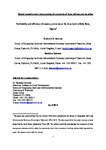Profitability and efficiency of cassava production at the farm-level in Delta State, Nigeria
| dc.contributor.author | Awerije, BO | |
| dc.contributor.author | Rahman, Sanzidur | |
| dc.date.accessioned | 2015-12-24T16:47:20Z | |
| dc.date.available | 2015-12-24T16:47:20Z | |
| dc.date.issued | 2014-07-01 | |
| dc.identifier.issn | 2047-3710 | |
| dc.identifier.uri | http://hdl.handle.net/10026.1/3995 | |
| dc.description.abstract |
The present study examines profitability, technical, cost and allocative efficiencies of cassava production by applying Data Envelopment Analysis (DEA) of 315 farmers from three regions of Delta State, Nigeria. Results revealed that cassava production was profitable (overall profit margin 1.93), with significant differences across regions as well as farm size categories. Mean levels of technical, cost and allocative efficiencies are low estimated at 40%, 29% and 73% respectively, also with significant differences across regions as well as farm size categories. The implication is that cassava production can be increased substantially by reallocation of resources to optimal levels, given input and output prices. The results also confirmed inverse size-productivity and size-efficiency relationships in cassava production, i.e., the marginal farms are the most productive, profitable, and efficient. Subsistence pressure significantly reduces technical and cost efficiency. Extension contact significantly improves allocative efficiency whereas it reduces technical and cost efficiency. There is no gender difference in performance implying both men and women performs equally well. Farmers located in Delta South and Delta North are technically efficient relative to Delta Central. However, farmers located in Delta North are allocatively inefficient. Investment in extension services to make it more effective and improvements in infrastructure are suggested as policy options. | |
| dc.format.extent | 210-218 | |
| dc.language | English | |
| dc.language.iso | English | |
| dc.publisher | International Farm Management Association and Institute of Agricultural Management | |
| dc.title | Profitability and efficiency of cassava production at the farm-level in Delta State, Nigeria | |
| dc.type | journal-article | |
| dc.type | Article | |
| plymouth.issue | 4 | |
| plymouth.volume | 3 | |
| plymouth.publication-status | Published | |
| plymouth.journal | International Journal of Agricultural Management | |
| dc.identifier.doi | 10.5836/ijam/2014-04-04 | |
| plymouth.organisational-group | /Plymouth | |
| plymouth.organisational-group | /Plymouth/Faculty of Arts, Humanities and Business | |
| plymouth.organisational-group | /Plymouth/Users by role | |
| dc.publisher.place | UK | |
| dcterms.dateAccepted | 2014-01-01 | |
| dc.rights.embargoperiod | Not known | |
| rioxxterms.versionofrecord | 10.5836/ijam/2014-04-04 | |
| rioxxterms.licenseref.uri | http://www.rioxx.net/licenses/all-rights-reserved | |
| rioxxterms.type | Journal Article/Review |


